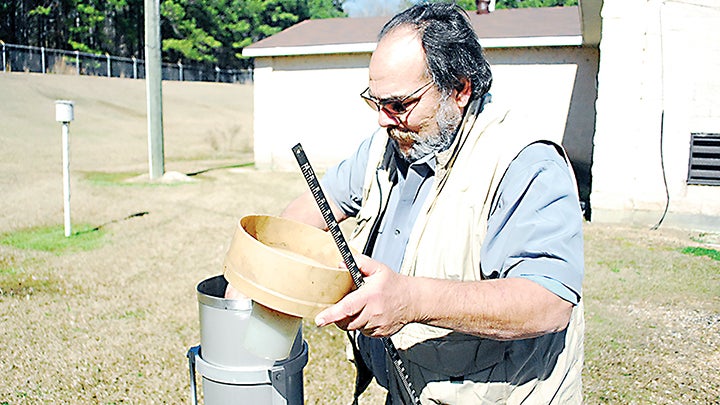Brookhaven Water Treatment plant operators gauge weather, too
Published 10:14 pm Thursday, February 8, 2018

- Photo by Trapper Kinchen/Ralph Augimeri measures local rainfall Thursday at the Brookhaven Wastewater Treatment Plant.
YOU ASKED:
Q: Who monitors the local weather?
A: Many have wondered who keeps track of the local weather, and, after conducting a little research, we discovered that the same folks who purify city water also monitor our regional climate.
The Brookhaven Wastewater Treatment Plant handles roughly 2.5 million gallons of wastewater per day, all of which comes from within the city limits. A small but efficient team operates the plant, and — due to the large quantity of municipal waste outputs — they stay busy.
In conjunction with treating city waste, the plant’s staff has closely monitored area weather for more than 50 years. They collect rainfall and keep track of hour-by-hour temperatures seven days a week.
Danielle Butler — the plant’s wastewater operator and lab technician — holds a Class 4 wastewater license, and she has worked in the field of water treatment for nearly a decade. She explained that the procedure through which the Brookhaven facility processes sewage is relatively complex and thorough.
First, local waste is collected and removed of solid material. Things like grease, paint, plastic and drivers licenses are extracted from Brookhaven’s wastewater before it is treated. An inordinate amount of trash sifts through city sewage, because, according to Butler, people usually don’t consider what should or shouldn’t go down a drain.
“Bathroom wipes actually cause more damage to the equipment out here than anything else,” Butler said.
After the wastewater is filtered of solids, it undergoes a course of bacterial filtration and aeration. That procedure prepares the water for purification.
The final sanitation process involves a sequence of water chlorination and de-chlorination. Subsequently, the purified liquid is discharged into the Halbert Branch of the Bogue Chitto River.
The Brookhaven Wastewater Treatment Plant follows strict state and federal environmental guidelines, and the liquid it expels into local waterways is extraordinarily clean.
“The water quality downstream from where we discharge is actually better than the water quality upstream,” Butler said.
Climate has a profound impact on how wastewater must be handled, and Butler observes local conditions very carefully. For example, she said cold weather means having to add more air to the plant’s bacterial tanks.
“Bacteria are just like us, they don’t like being too cold. So we give them more oxygen to keep them viable,” she said.
Meanwhile, bacterial levels typically rise during warm weather, and higher microbial concentrations result in more solid waste that must be separated from the city’s purifying water. So, the plant’s staff adds and removes bacteria to their aeration pools according to daily temperature readings.
“If you have more solids, your ammonia is going to go up, your biological oxygen demand is going to go up and your dissolved oxygen is going to go down,” Butler said.
Rainfall also impacts the way local wastewater is treated. The plant has to keep the water in its tanks balanced as precipitation ebbs and flows.
“Say it’s one of those springs where we get 12-inches of rain a week. That would overwhelm our system, so we send some of that over to our lagoon. And, in periods of drought, to keep things steady, we bring that water back to the plant,” she said.
Ralph Augimeri, Butler’s supervisor, has more than 40 years of experience in the water treatment business. He said the Brookhaven plant does more than just purify waste. He believes it is responsible for making the city possible.
“Wastewater treatment facilities make civilization possible. You cannot confine people to this tight of an area without providing a means for the disposal of waste,” he said.





